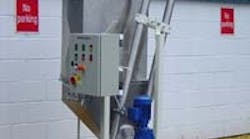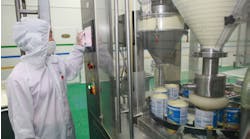A portable mechanical conveyor has been instrumental in helping Soliant LLC, Lancaster, S.C., improve the production of Fluorex thermoplastic paint. The Aero Mechanical Conveyor from Spiroflow Systems, Charlotte, N.C., ensures a consistent flow of soft acrylic powder, without lumps or sticking, into a large cylindrical mixing vessel used at the start of the paint-making process.
Soliant, a wholly-owned subsidiary of Ernie Green Industries, a Dayton, Ohio-based automotive supplier, offers Fluorex as a more durable, cost effective and environmentally friendly alternative to traditional paint and plating systems. The material currently comes in a palette of more than 140 colors, and is used by a variety of industries including automotive, marine, signage and electronics.
Before purchasing the conveyor, Soliant employees manually pushed 275-lb. drums filled with acrylic resin powder onto a scale for weighing and adding to the mix. Two operators then manually scooped 1.5 lb. at a time from the drums to the mixing vessel until the amount called for in the particular recipe was reached. In the vessel, the powder was stirred into a mixture about the thickness of mayonnaise.
Before scooping material into the mixing vessel, operators first had to hand inspect the contents of each drum and physically break up any lumps or sticky powder. Speed and consistency varied from batch to batch. Each required an average of 25 minutes per employee or almost one man-hour.
"The manual system was time consuming and didn’t provide the quality control we needed," notes Mark Beard, staff product development engineer for Soliant. "We needed a dependable, hands-off system that ensured batch-to-batch consistency and automatically provided a consistent speed and material flow."
A better way
Beard did some research and saw an ad for the portable Aero Mechanical Conveyor. "We had no knowledge of Spiroflow's capabilities, even though they were in our backyard," he says. "After visiting their facility, we were convinced that Spiroflow had the know-how and expertise we were looking for. A demonstration using our powder convinced us that their equipment was right for the job."
The system designed and custom built by Spiroflow consists of a stainless steel conveyor and a distribution system comprised of an inclined 90-in.-long straight-line conveyor with a sack tip hopper at the inlet. The system is mounted on a mobile frame complete with two fixed and two swivel casters. The casters ensure easy positioning and have locking brakes for maximum safety.
When material must be added to the mixer, the mobile conveyor is positioned onto a 4 ft. × 4 ft. weight platform whose top is flush with the factory floor. Then the weight of the conveyor is tared so that the precise amount of acrylic powder can be loaded into the conveyor feed hopper. The powder is tipped into the hopper through a plastic strip curtain located at the front of the dust hood above it. The hood is connected to a dust extraction system that ensures environmentally safe dust-free operation. A grid across the top of the hopper breaks up any agglomerates, a main concern with the previous procedure. A rotary valve controls the rate of flow from the hopper to the conveyor. Six air-operated vibratory pads strategically placed around the hopper ensure a consistent flow of powder into the rotary valve at the hopper outlet without bridging.
The conveyor has 3-in. conveying tubes and operates at a 45-degree angle. An air motor powers both the conveyor and rotary valve as is common in hazardous environments. An inner-locked access panel facilitates cleaning of the internal conveyor components and a vision panel in one of the conveying tubes enables operators to determine when cleaning is required. Because the unit is self-emptying, cleaning only is necessary if there's a build-up of a sticky or cohesive product or to avoid cross-contamination between batches.
The conveyor systems consist of several evenly spaced polyurethane disks attached to a wire rope. The rope and disks travel in a continuous loop within parallel steel tubes. At each end, the rope assembly runs from one tube to the other around specially designed sprockets. One of the sprockets drives the rope and disks while the other provides tension to the rope. By maintaining the rope and disk assembly at a constant high speed, the conveyor produces an air stream that fluidizes and conveys product to the mixing vessel where the powder is centrifugally ejected. This method of conveying action allows production capacity to be ramped up or down with low energy requirements and minimal product degradation and separation.
The problem of lumpy, sticky powder has been eliminated, making it a virtually worry-free operation, according to Beard.
"It's a quality worry-free piece of equipment we are glad to have," he says. "Pouring into the vessel is consistent and we find the system extremely dependable. Instead of over an hour in labor required under the old method, the same process takes under 20 minutes, is totally automatic and requires little or no supervision."
The system is virtually maintenance free, adds Beard. In the over five years since installation, the only routine maintenance required relates to cleaning and rope tensioning.
A solid choice
The Aero Mechanical Conveyor provides high productivity and dust-free operation. Its features include total batch transfer, flexible operation at any angle without loss of capacity, a sealed system for contaminant-free delivery and a removable housing around the conveyor for easy cleaning. Units are available to handle volumes of up to 120 tons per hour.
Besides free-flowing powders such as acrylics, flour and carbon black, the system also can convey difficult materials such as titanium dioxide. In addition, it has no problem with granules, flakes or chips.
Michel Podevyn is president and CEO of Spiroflow Systems, Inc., Charlotte, N.C. E-mail him at [email protected].


